Phase-modulated shifted-echo MQMAS
AIM: We provide Mathematica-5 notebooks and SIMPSON1.1.1 Tcl scripts to optimize the echo amplitude or that of antiecho for phase-modulated shifted-echo MQMAS NMR experiment applied to half-integer quadrupole spin.
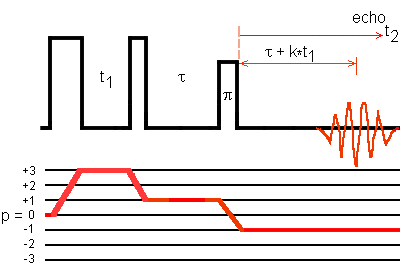
Fig. 1: Phase-modulated shifted-echo MQMAS pulse sequence and 3Q echo coherence transfer pathway of a spin I = 5/2 system.
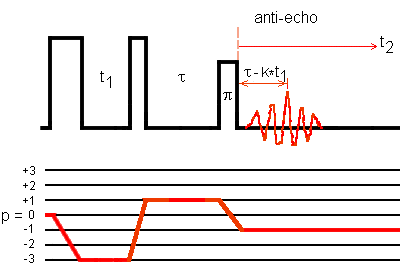
Fig. 2: Phase-modulated shifted-antiecho MQMAS pulse sequence and
-3Q antiecho coherence transfer pathway of a spin I = 5/2 system.
The echo amplitude and the antiecho amplitude have opposite signs.
Method: We simulate the echo and the antiecho amplitudes of a spin I = 5/2 versus an increasing pulse duration in a powder rotating at the magic angle, using Mathematica-5 notebooks.
The parameters for these simulations are:
- Nucleus: 27Al
- Spin: 5/2
- 27Al Larmor frequency: 208.61889974 MHz
- Proton Larmor frequency: 800 MHz
- All 3Q or -3Q coherences of the density matrix at the end of the first pulse are taken into account for the simulation
- All 1Q coherences of the density matrix at the end of the second pulse are taken into account for the simulation
- Amplitude of the strong radio-frequency pulse: 100 kHz
- Amplitude of the weak radio-frequency pulse: 10 kHz
- Pulse duration increment: 0.25 μs
- Rotor spinning speed: 15 kHz
- Quadrupole interaction: first and second orders
- Quadrupole coupling constant: 5 MHz
- Asymmetry parameter: 1
- Crystal file: rep100_simp
- Number of summation steps of the Euler angle γ of the rotor: 10
(A) Mathematica-5 notebook
(1) Preliminary
| Echo optimization with |
Notebook | SIMPSON 1.1.1 |
|---|---|---|
| strong pulse p1 | echo_P1 (pdf) | echo_P1 |
| strong pulse p2 | echo_P2 (pdf) | echo_P2 |
| soft pulse p3 | echo_P3 (pdf) | echo_P3 |
| Antiecho optimization with |
Notebook | SIMPSON 1.1.1 |
|---|---|---|
| strong pulse p1 | antiecho_P1 (pdf) | antiecho_P1 |
| strong pulse p2 | antiecho_P2 (pdf) | antiecho_P2 |
| soft pulse p3 | antiecho_P3 (pdf) | antiecho_P3 |
- Download Mathematica-5 notebooks, that for MAS NMR utilities QUADRUPOLE_1_0.nb (the corresponding PDF file), and the crystal file rep100_simp.
- Save these files into Mathematica-5 folder. Forbidden the Operating System of your computer to include extra file extension to rep100_simp by providing the file name with double quotes such as "rep100_simp".
- Open QUADRUPOLE_1_0.nb file with Mathematica-5.
- Press "Ctrl-A" to select the notebook, then press "Shift-enter" to start the notebook. (Some warning messages appear but they have no consequences on the results.) A new file called QUADRUPOLE is created in Mathematica-5 folder.
(2) Simulation
- Open a Mathematica-5 notebook such as shifted_echo_P2.nb.
- Press "Ctrl-A" to select the notebook, then press "Shift-enter" to start simulation. (Some warning messages precede the simulation.) At the end a data file called shifted_echo_P2 is created in Mathematica-5 folder. MS Excel can open this data file for graphic representation.
(B) Result
Figures 3 to 6 represent simulated data.
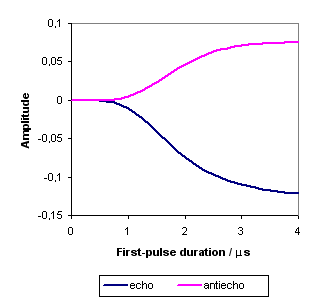
Fig. 3: 27Al shifted 3Q echo and shifted -3Q antiecho amplitudes versus the first-pulse duration. The second-pulse duration is 1 μs for the echo and 1.75 μs for the antiecho. The third-pulse duration is 15 μs. Notebook filenames: shifted_echo_P1.nb and shifted_antiecho_P1.nb.
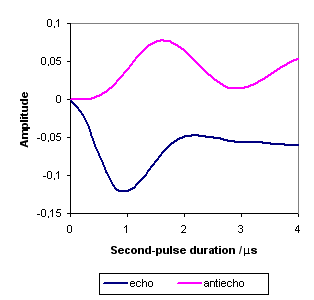
Fig. 4: 27Al shifted 3Q echo and shifted -3Q antiecho amplitudes versus the second-pulse duration. The first-pulse duration is 4 μs. The third-pulse duration is 15 μs. Notebook filenames: shifted_echo_P2.nb and shifted_antiecho_P2.nb.
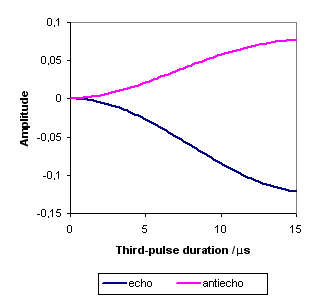
Fig. 5: 27Al shifted 3Q echo and shifted -3Q antiecho amplitudes versus the third-pulse duration. The first-pulse duration is 4 μs. The second-pulse duration is μs for the echo and 1.75 μs for the antiecho. Notebook filenames: shifted_echo_P3.nb and shifted_antiecho_P3.nb.
Figures 3 to 5 show that the first extreme value of echo amplitude is larger than that of the antiecho. The explanation is similar to that given for the simulation of amplitude-modulated two-pulse sequence. That is, the two coherence transfer pathways are not symmetrical. The coherence order change from p = 3 to p = 1 is two for the echo pathway whereas that from p = -3 to p = 1 is four for the antiecho pathway. The important coherence order change in the antiecho transfer pathway reduces the antiecho amplitude.
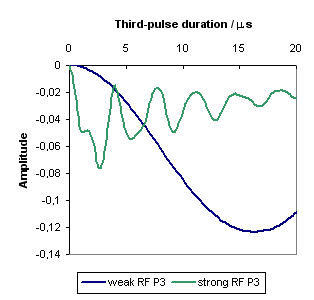
Fig. 6: 27Al shifted 3Q echo amplitude versus the third-pulse duration. The first-pulse duration is 4 μs. The second-pulse duration is 1 μs. The RF field generating the third pulse is 10 kHz for weak pulse and 100 kHz for strong pulse. Notebook filename: shifted_echo_P3.nb.
Figure 6 shows that a weak third pulse generates larger echo amplitude than a strong third pulse.
(C) Conclusion
Since the phase-modulated split-t1 sequences and the phase-modulated shifted-echo sequences have the same coherence transfer pathways, the notebooks and Tcl scripts for echo and antiecho amplitude simulation are valid for these phase-modulated sequences too.
